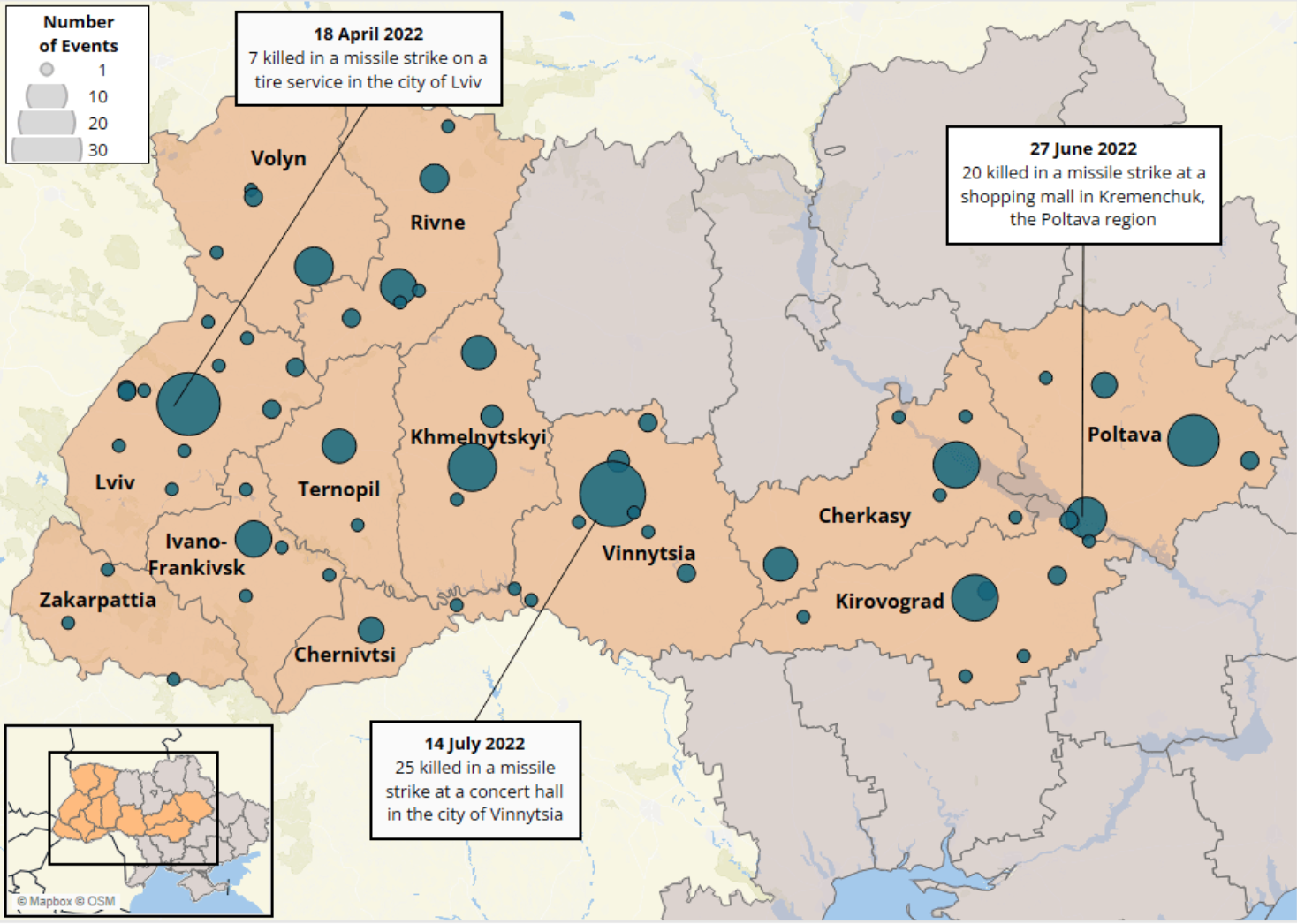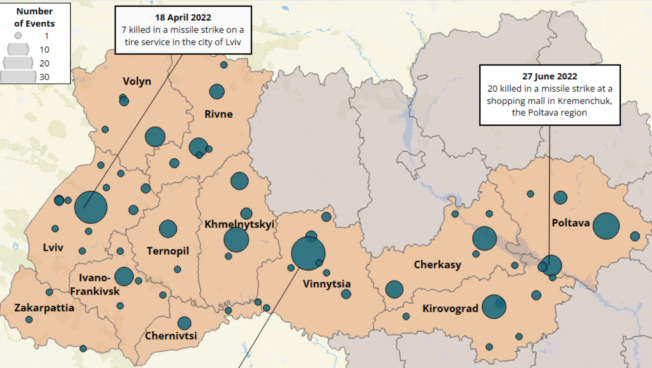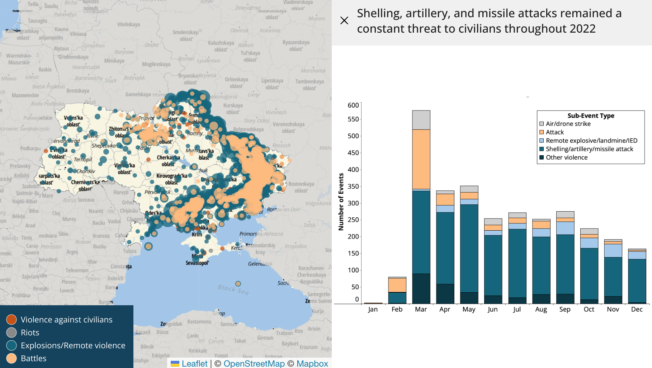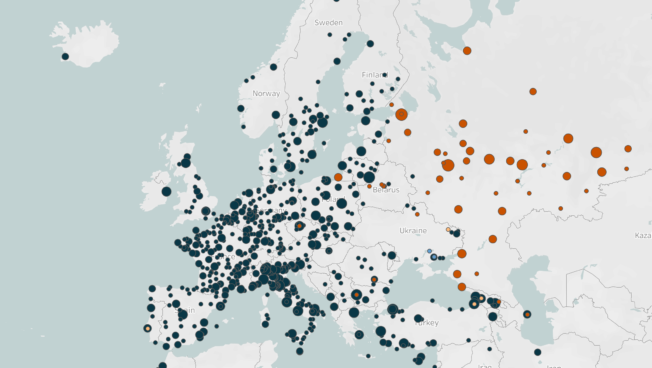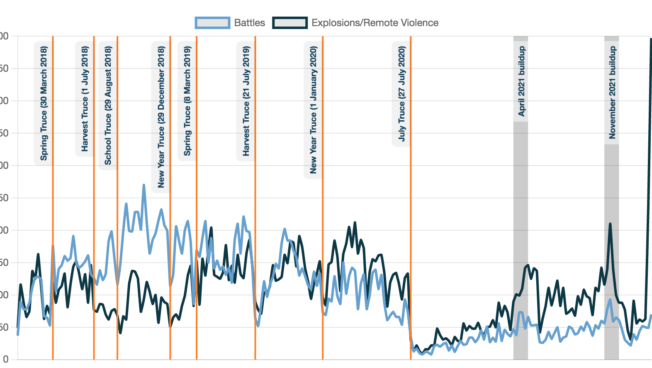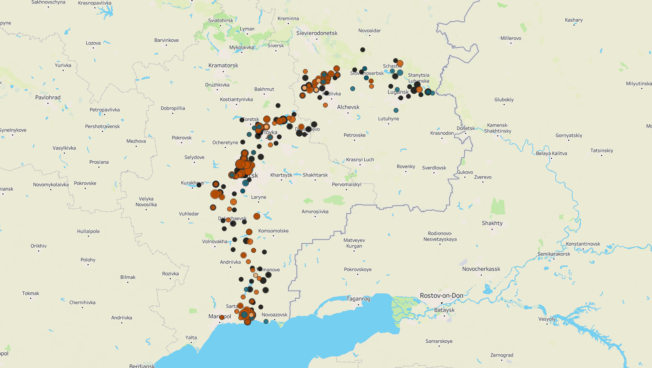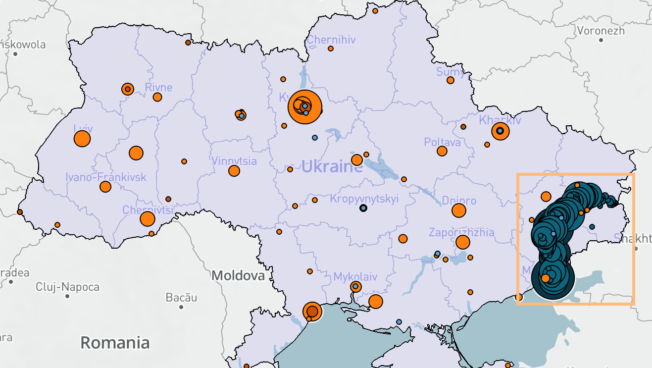Featured Report
War in Ukraine: One Year On, Nowhere Safe
This report analyzes key trends in ACLED data since the start of the Russian invasion.
ACLED’s Ukraine Conflict Monitor provides near real-time information on the war, including an interactive map of the latest data from the start of the invasion onward, a curated data file, and weekly situation updates.
The Monitor is designed to help researchers, policymakers, media, and the wider public track key conflict developments in Ukraine over the course of the war. It is updated every Wednesday, with data covering events from the previous week. ACLED data reflect the best available information at the time of release, and are regularly updated as new or better information becomes available.
Due to the methodological limitations of event-based data collection, in addition to the broader challenges around fatality reporting in fast-moving conflict contexts like Ukraine, fatality estimates in the ACLED dataset pertain specifically to those fatalities reported in connection with distinct events that meet ACLED’s catchment and minimum threshold for inclusion (i.e. date, location, and actor information). This means that aggregate tallies provided by sources such as hospitals and government agencies, for example, which cannot be broken down and connected to individual conflict incidents, are not included in the ACLED dataset. ACLED fatality numbers are conservative event-based estimates, and the full death toll in such contexts is likely higher than the number of reported fatalities currently attributed to the type of distinct incidents that can be captured in the dataset. For these reasons, the Monitor will not be providing regular fatality estimate updates at this time.1Tracking fatalities is one of the most difficult aspects of conflict data collection in general, as fatality counts are frequently the most biased, inconsistent, and poorly documented components of conflict reporting, and this is especially true of active conflict environments impacted by high levels of mis/disinformation and severe access constraints. ACLED defaults to conservative estimates based on the best available information at the time of coding in line with our specific event-based methodology and review process. ACLED estimates are restricted to fatalities reported during individual events, meaning that these estimates may be particularly conservative in comparison with sources that do not use an event-based methodology. When and where possible, ACLED researchers seek out information to triangulate the numbers from any report, but we do not independently verify fatalities. ACLED is also a ‘living dataset’, so all fatality figures are revised and corrected — upward or downward — if new or better information becomes available (which, in some conflict contexts, can be months or years after an event has taken place). These figures should therefore be understood as indicative estimates rather than definitive fatality counts (for more on ACLED’s approach to coding fatalities, see FAQs: ACLED Fatality Methodology). ACLED additionally only captures fatalities that are directly caused by political violence; indirect conflict-related fatalities caused by disease or starvation, for example, are not included in these estimates. Other sources may come to different figures due to differing methodologies and catchments.
May Data Pause: ACLED data updates are paused for the second and third weeks of May 2023. Data covering the period of 29 April to 19 May will be published according to the regular data release schedule on Monday, 22 May, and Tuesday, 23 May. Standard updates on Monday and Tuesday will resume the following week. Thank you for your understanding during this temporary schedule adjustment. Please reach out to [email protected] if you have any questions or concerns.
29 April – 5 May 2023
Fighting between Russian and Ukrainian forces continued in the areas of Bakhmut and Avdiivka in the Donetsk region, and along the Kreminna-Svatove-Kupiansk line in the Luhansk and Kharkiv regions. Limited clashes were also recorded around Orikhiv in the Zaporizhia region.2Riley Bailey et al., ‘Russian Offensive Campaign Assessment, May 4, 2023,’ Institute for the Study of War, 4 May 2023 Ukrainian forces reportedly engaged in counterattacks in and around Bakhmut3Karolina Hird et al., ‘Russian Offensive Campaign Assessment, May 5, 2023,’ Institute for the Study of War, 5 May 2023; Ukrinform, ‘In Certain Areas of Bakhmut, Russian Forces were Counterattacked and Left Some Positions,’ 1 May 2023 and continued raids across the Dnipro river in the Kherson region.4Riley Bailey et al., ‘Russian Offensive Campaign Assessment, May 1, 2023,’ Institute for the Study of War, 1 May 2023
Russian forces continued intense shelling of frontline regions, damaging civilian infrastructure. On 3 May, Russian artillery, drones, and airstrikes targeted different parts of Kherson city, including a supermarket, a gas station, and a rail station, killing 24 civilians and wounding over 40.5Vitalii Sayenko, ‘Bloody Attack on Kherson: the Number of Fatalities Increased to 24 People,’ Unian, 8 May 2023 Russian forces also increased the frequency of coordinated missile and drone strikes throughout the week, targeting areas further from the frontline, including Kyiv city and the Dnipropetrovsk, Kirovohrad, and Odesa regions. Russian missiles hit Pavlohrad in the Dnipropetrovsk region on 1 May killing two civilians and wounding 48, as well as damaging hundreds of civilian buildings.6Ukrinform, ‘Around 300 Private Houses Damaged due to a Missile Strike on Pavlohrad on 1 May,’ 5 May 2023
For previous situation updates and infographics, click here.
Interactive Dashboard
This dashboard includes political violence events in Ukraine since the start of the Russian invasion on 24 February 2022. By default, the map displays data for the most recent week. Use the filters on the left to analyze trends in more detail.
Curated Data
This file contains all political violence events, demonstration events, and strategic developments recorded in Ukraine and the Black Sea from the beginning of ACLED coverage in 2018 to the present.
For an overview, see our interactive dashboard.
Information & Analysis
For additional information on the conflict in Ukraine, check our analysis of political violence trends from the start of ACLED coverage in 2018.


